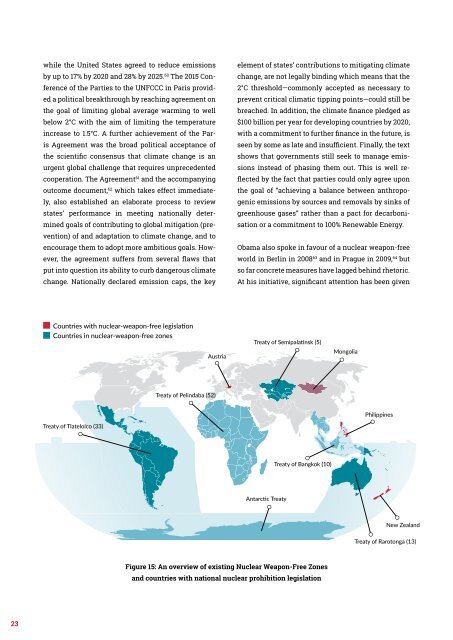THE CLIMATE-NUCLEAR NEXUS
1ThUv98
1ThUv98
Create successful ePaper yourself
Turn your PDF publications into a flip-book with our unique Google optimized e-Paper software.
while the United States agreed to reduce emissions<br />
by up to 17% by 2020 and 28% by 2025. 60 The 2015 Conference<br />
of the Parties to the UNFCCC in Paris provided<br />
a political breakthrough by reaching agreement on<br />
the goal of limiting global average warming to well<br />
below 2°C with the aim of limiting the temperature<br />
increase to 1.5°C. A further achievement of the Paris<br />
Agreement was the broad political acceptance of<br />
the scientific consensus that climate change is an<br />
urgent global challenge that requires unprecedented<br />
cooperation. The Agreement 61 and the accompanying<br />
outcome document, 62 which takes effect immediately,<br />
also established an elaborate process to review<br />
states’ performance in meeting nationally determined<br />
goals of contributing to global mitigation (prevention)<br />
of and adaptation to climate change, and to<br />
encourage them to adopt more ambitious goals. However,<br />
the agreement suffers from several flaws that<br />
put into question its ability to curb dangerous climate<br />
change. Nationally declared emission caps, the key<br />
element of states’ contributions to mitigating climate<br />
change, are not legally binding which means that the<br />
2°C threshold—commonly accepted as necessary to<br />
prevent critical climatic tipping points—could still be<br />
breached. In addition, the climate finance pledged as<br />
$100 billion per year for developing countries by 2020,<br />
with a commitment to further finance in the future, is<br />
seen by some as late and insufficient. Finally, the text<br />
shows that governments still seek to manage emissions<br />
instead of phasing them out. This is well reflected<br />
by the fact that parties could only agree upon<br />
the goal of “achieving a balance between anthropogenic<br />
emissions by sources and removals by sinks of<br />
greenhouse gases” rather than a pact for decarbonisation<br />
or a commitment to 100% Renewable Energy.<br />
Obama also spoke in favour of a nuclear weapon-free<br />
world in Berlin in 2008 63 and in Prague in 2009, 64 but<br />
so far concrete measures have lagged behind rhetoric.<br />
At his initiative, significant attention has been given<br />
Countries with nuclear-weapon-free legislation<br />
Countries in nuclear-weapon-free zones<br />
Austria<br />
Treaty of Semipalatinsk (5)<br />
Mongolia<br />
Treaty of Pelindaba (52)<br />
Philippines<br />
Treaty of Tlatelolco (33)<br />
Treaty of Bangkok (10)<br />
Antarctic Treaty<br />
New Zealand<br />
Treaty of Rarotonga (13)<br />
Figure 15: An overview of existing Nuclear Weapon-Free Zones<br />
and countries with national nuclear prohibition legislation<br />
23


